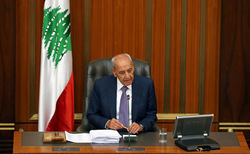 Lebanese Parliament Speaker Nabih Berri paid tribute to the Iranian Islamic Revolution of 1979 with sending separate messages to the senior officials of the Islamic Republic on the 41st anniversary of the victory of the Islamic Revolution.
Lebanese Parliament Speaker Nabih Berri paid tribute to the Iranian Islamic Revolution of 1979 with sending separate messages to the senior officials of the Islamic Republic on the 41st anniversary of the victory of the Islamic Revolution. RNA - Berri on Friday cabled Supreme Leader of the Islamic Revolution Ayatollah Seyed Ali Khamenei, congratulating him upon the anniversary of the Islamic Revolution.
He also sent similar messages to his counterpart Ali Larijani and Iranian President Hassan Rouhani.
Celebrations for the 41st anniversary of the victory of the Islamic Revolution of 1979 were officially kicked off with the visit of Supreme Leader of the Islamic Revolution Ayatollah Seyed Ali Khamenei to the mausoleum of Imam Khomeini in the Southern outskirts of Tehran on last Saturday.
Ayatollah Khamenei visited the mausoleum of Imam Khomeini to pay tribute to the founder of the Islamic Revolution as the 10-day celebrations marking the anniversary of the 1979 Islamic Revolution begin in Iran.
The Leader made the visit early on last Saturday, which marks the day Imam Khomeini returned to the Iranian capital city of Tehran on February 1, 1979, ten days before the Revolution, which ended the monarchy of the US-backed Pahlavi regime in the country.
After performing prayers in the mausoleum, Ayatollah Khomeini also visited the nearby Behesht Zahra cemetery, where Imam Khomeini delivered his first speech after the exile, in an address to five million people.
The leader also paid tribute to Iranian martyrs who have lost their lives since the Islamic Revolution.
Nationwide ceremonies kicked off at 9:33 am local time (0603 GMT), marking the exact time when Imam Khomeini landed in the Iranian capital.
A special public ceremony is also held at the Imam Khomeini mausoleum, with a host of senior state and military officials as well as thousands of people from all walks of life in attendance.
Imam Khomeini’s return to the country ultimately resulted in the overthrow of the shah, Mohammad-Reza Pahlavi.
Despite being contrary to the wishes of Iran’s rulers at the time, the Imam's return, after a 15-year exile, was made possible due to the sheer abundance of popular support for the revolutionary leader among the masses.
Speaking on Friday, Iran's Foreign Ministry Spokesman Abbas Mousavi said that “41 years ago, the most popular revolution took place”. He added that Iran’s Islamic government resulting from the revolution has relied solely on “the people” ever since.
Iran has annually commemorated the events with 10-Day Dawn festivities, which culminate in nationwide rallies on February 11, marking the anniversary of the Islamic Revolution.
Led by the Founder of the Revolution, Imam Khomeini, Iranians confronted the forces of US-proxy Mohammad-Reza Pahlavi in late 1977 to end his oppressive, cruel and autocratic rule over the country.
By December 1978, millions of Iranians would take to the streets in protest against the policies of the Shah on a regular basis.
Grand Ayatollah Ruhollah Khomeini returned from exile to Iran to be received by millions of cheering crowds after the departure of the Shah in mid-January 1979. Two weeks later, the country saw the victory of the Islamic Revolution.
The final collapse of the Shah's regime came on February 11 when the military renounced its loyalty to the Shah and joined the revolutionary forces.
847/940